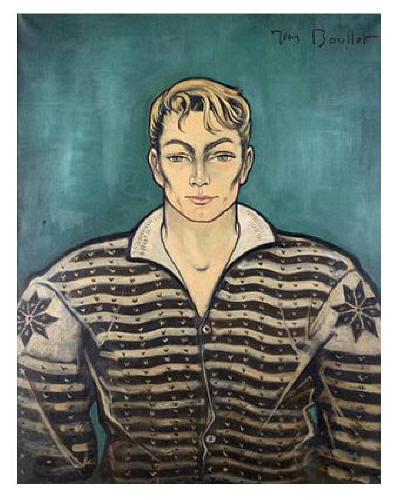Partner Jean
Cocteau,
George Reich
Queer Places:
Lycée Condorcet, 8 Rue du Havre, 75009 Paris, Francia
Cimetière de Vallauris
 Jean-Alfred
Villain-Marais, also known as Jean Marais (11 December 1913 – 8 November
1998), was a French actor, writer, director and sculptor. He performed in over
100 films and was the muse of acclaimed director
Jean Cocteau.[1]
In 1996, he was awarded the French Legion of Honor for his contributions to
French Cinema.[2]
The last King of Italy,
Umberto II, is said to have numbered among his lovers
Luchino Visconti,
Jean Marais and the boxer
Primo Carnera.
Jean-Alfred
Villain-Marais, also known as Jean Marais (11 December 1913 – 8 November
1998), was a French actor, writer, director and sculptor. He performed in over
100 films and was the muse of acclaimed director
Jean Cocteau.[1]
In 1996, he was awarded the French Legion of Honor for his contributions to
French Cinema.[2]
The last King of Italy,
Umberto II, is said to have numbered among his lovers
Luchino Visconti,
Jean Marais and the boxer
Primo Carnera.
A native of Cherbourg, France, Marais was a son of Alfred Emmanuel Victor
Paul Villain-Marais and his wife, the former Aline Marie Louise Vassord.[3]
In 1933, Marais was discovered by filmmaker Marcel L'Herbier, who purchased
one of his paintings, then cast him in two films, L'Épervier and
L'Aventurier. Marais starred in several movies directed by Jean Cocteau,
for a time his lover and a lifelong friend, most famously Beauty and the
Beast (1946) and Orphée (1949).
During the post-WWII period, the French theatre was
dominated by Jean Cocteau's circle, including the stage designer
Christian
Bérard and the actor Jean Marais; the bisexual
Gérard Philipe was everyone's favorite leading man. The foremost members
of the Comedic Francaise, such as Jean Weber and
Jacques Charon,
were familiar faces at gay salons. Julien Green's monumental Sud
(South, 1953)
clothed his doomed love story in Civil War garb and veiled suggestion; the
agony of unrequited affection went even deeper in
Henry de Montherlant's La Ville
dont le Prince en un Enfant (The City Whose Prince Is a Child, 1951), set
in a Catholic school where an obsessive priest roots out the special
friendships of the students. Typically, the secretive and suicidal Montherlant
considered it unsuitable for public performance by boys.
In the 1950s, Marais became a star of swashbuckling pictures, enjoying
great box office popularity in France. He performed his own stunts. In the
1960s, he played both the famed villain and the hero of the Fantômas
trilogy. In 1963, he was a member of the jury at the 3rd Moscow International
Film Festival.[4]
After 1970, Marais's on-screen performances became few and far between, as
he preferred concentrating on his stage work. He performed on stage until his
eighties, also working as a sculptor. His sculpture Le passe muraille (The
Walker Through Walls) can be seen in the Montmartre Quarter of Paris.[5]

by Carl Van Vechten

Jean Marais (1913-98)
Actor
Paris, 10 May 1946
Vintage print
Vogue, The Condé Nast Publications Ltd

Jean Marais by Jean Boullet
In 1985, he was the head of the jury at the 35th Berlin International Film
Festival. He was featured in the 1995 documentary Screening at the Majestic,
which is included on the 2003 DVD release of the restored print of Beauty
and the Beast.[6]
Marais appears on the cover sleeve of The Smiths single "This Charming Man".
He was married for two years to the actress Mila Parély, with whom he later
performed in Cocteau's Beauty and the Beast.[7]
Marais, who was bisexual, was the muse and lover of Jean Cocteau until
Cocteau's death.[8]
After Cocteau's death, Marais wrote a memoir of Cocteau, L'Inconcevable
Jean Cocteau, attributing authorship to "Cocteau-Marais". He also wrote an
autobiography, L'Histoire de ma vie, published in 1975. From 1953 until
1959, his companion was the American dancer
George Reich.[3]
In the early 1960s, Marais adopted a young man, Serge Ayala, who eventually
took the name Serge Villain-Marais. This adopted son, who became a singer and
an actor, committed suicide in 2012 at age 69.[9]
Marais died from cardiovascular disease in Cannes, Alpes-Maritimes, in
1998. He is interred in the Village cemetery at Vallauris, near Antibes.[10]
His life story became the inspiration for the 1980 François Truffaut film
The Last Metro.[11]
My published books:


BACK TO HOME PAGE

- https://en.wikipedia.org/wiki/Jean_Marais
- Woods, Gregory. Homintern . Yale University Press. Edizione del
Kindle.
- Homosexuals in History, A Study of Ambivalence in Society, Literature
and the Arts, by A.L. Rowse, 1977
 Jean-Alfred
Villain-Marais, also known as Jean Marais (11 December 1913 – 8 November
1998), was a French actor, writer, director and sculptor. He performed in over
100 films and was the muse of acclaimed director
Jean Cocteau.[1]
In 1996, he was awarded the French Legion of Honor for his contributions to
French Cinema.[2]
The last King of Italy,
Umberto II, is said to have numbered among his lovers
Luchino Visconti,
Jean Marais and the boxer
Primo Carnera.
Jean-Alfred
Villain-Marais, also known as Jean Marais (11 December 1913 – 8 November
1998), was a French actor, writer, director and sculptor. He performed in over
100 films and was the muse of acclaimed director
Jean Cocteau.[1]
In 1996, he was awarded the French Legion of Honor for his contributions to
French Cinema.[2]
The last King of Italy,
Umberto II, is said to have numbered among his lovers
Luchino Visconti,
Jean Marais and the boxer
Primo Carnera.




